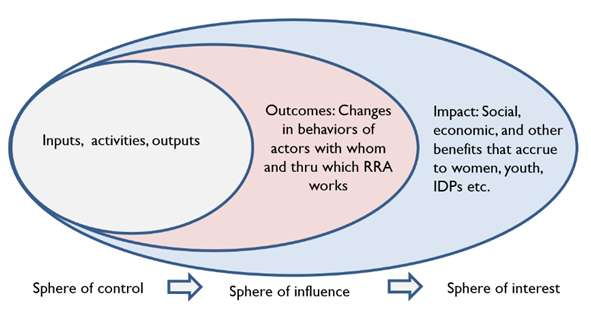How do you rise to the challenge of extending equitable economic opportunities to more than 600,000 women and men in Northeastern Nigeria ?
How do you rise to the challenge of extending equitable economic opportunities to more than 600,000 women and men in Northeastern Nigeria ?
In this latest installment of the Canopy Lab’s In Search of More Equitable Impact blog, I spoke with John Rachkara, Deputy Chief of Party, and Anuoluwapo Fashola (Anu), Gender Advisor for the USAID Feed the Future Rural Resilience Activity (RRA) implemented by Mercy Corps in partnership with IFDC and Save the Children International, about how they are facilitating economic growth in a complex environment. John and Anu shared three practical ways they are rising to this challenge.
1) Create dialogue on the importance of shared value/benefits.
John thinks about RRA in terms of three spheres: control, influence, and interest (Fig.1). He believes that achieving more equitable impact is dependent upon expanding the sphere of interest of market actors to ensure benefits accrue to more marginalized groups (e.g., women, youth, displaced people, etc.) within a community.

Figure 1: Spheres of control, influence and interest
He does this by leveraging the co-creation process to engage the potential partner in dialogue around what the partnership may mean for the lives and livelihoods of different groups and how much of the benefits created by the partnership will stay in the community. These discussions are then codified in partnership agreements. John finds that this process helps expand the spheres of interest and influence of market actors to ensure benefits are enjoyed by more marginalized groups.
“We are very intentional in our partnership and negotiation documents to ensure that whatever benefit we generate is shared equitably with the participants in their supply chain.” — John Rachkara
However, according to John, the reaction to this ‘shared value’ varies across actors. He finds that trading partners have a different, more negative initial reaction than social enterprises and service providers. However, when he makes the economic case that more money flowing through local economies creates the opportunity for greater economic participation, he finds that even the more reluctant private actors are responsive. As a result of this process, not only are partners more engaged on the topic of inclusion, but also John has also observed a noticeable shift in team members who now all identify as gender champions.
2) Get everyone on the team to identify as a gender champion.
Turning the entire RRA team into gender champions took a combination of formal training, coaching and mentoring sessions. According to John, it also required a mindset shift. Leading this change process was RRA’s Gender Advisor, Anuoluwapo (Anu) Fashola. When Anu joined RRA in 2020, she held a strong belief in the power of gender equality and social inclusion (GESI) mainstreaming in programming to achieve results. However, she soon realized the team members had different levels of understanding and conviction. She recalled some people saying ‘I don’t know why you are telling us to reach 50% women, I don’t think this approach will give us results.’ Fortunately, other team members were more aware, and some were even integrating GESI processes into their work on an ad hoc basis. However, Anu knew that she could only achieve success if she had the whole team onboard. So she set out to turn the entire team into gender champions (Fig. 2)
“I need to have the team with me, there is no way I can do this alone.” — Anuoluwapo (Anu) Fashola

Figure 2: Gender Champion Activities
Anu started by systematically demystifing and deepening the understanding of GESI for her team members. She started with a GESI analysis which then informed the strategy and roadmap to identify practical entry points. For example, integrating specific objectives and activities around GESI in the RRA’s Activity work plan was a concrete way to bring more attention to GESI to then establish targets and secure resources for capacity building on GESI strategies for staff and partners. Another entry point was the project’s results chains which explicitly reference different groups (e.g. women, youth, IDPs, etc.) throughout focusing attention on engagement and experience of different groups. Additionally, integrating specific sections in the partner proposal template on GESI was yet another way she was able to focus staff and partner attention to GESI.
While mainstreaming GESI in project and partner documents was an important step, Anu quickly realized that if partners did not understand the importance of GESI and how their actions can empower different groups, then RRA would not achieve its inclusion objectives. To ensure RRA meets such objectives, they started training partners on GESI practices and included an emphasis on practical co-creation tools that would help the partner better understand how their work was impacting (or not) different groups.
3) Trace your impact
To better understand and measure how different groups within the local economy benefit from the investments facilitated by the activity, John and the RRA team use outcome mapping and most significant change methodologies, among other more traditional impact measurement tools.
The team starts by looking at how the local economy benefited from an investment in a local business facilitated by RRA and then traces those benefits through the system to see how the investment impacted community members. Then, they probe further to see how the benefits accrued to women and youth. The team uses this information to answer the following questions:
- What worked well?
- What could have been done differently to create more impact?
- Did the investment facilitate positive or negative changes in terms of participation by women and youth?
“Asking these types of probing questions helps us to reflect and to nuance our work better.” — John Rachkara
These more qualitative research approaches not only help community members tell their version of the story in an organic way, but they also yield important insights into the different pathways of behavioral change. John finds that this type of storytelling is a powerful way to amplify positive behaviors among different groups– especially women and youth– and encourage their uptake.
----------------------------------------------
The Rural Resilience Activity (RRA) is a USD 49M investment, funded by USAID Feed the Future (FtF). It facilitates economic recovery and growth in vulnerable, conflict-affected areas by promoting systemic change in market systems and strengthening the resilience capacities of markets, businesses, and people. It contributes to the FtF initiative to address hunger and food insecurity by promoting sustainable agriculture, improving nutrition, and fostering economic growth. RRA focuses on increasing productivity through expanded on-farm and off-farm market opportunities, promoting market access and trade, improving nutrition outcomes, and building the resilience of people and markets to various shocks.
This blog series is written by Holly Lard Krueger, Managing Partner and Inclusion+ Practice Lead at the Canopy Lab, a Washington, DC based consulting firm specialized in the practical application of systems thinking.


